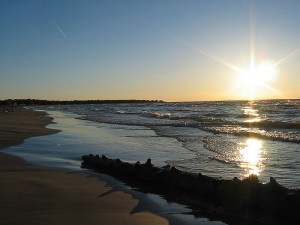
New standards will decide if this is a safe place to swim. Photo: Wikimedia Commons.
After 16 years of research federal officials are set to release sometime this month new standards for deciding if a beach is safe for people to have fun.
The current standard was set in 1996, updated from an initial standard set in the 1980s by the United State Environmental Protection Agency, said Joan Rose, director of the Water Quality, Environmental and Molecular Microbiology Laboratory at Michigan State University.
“They do need a new criteria,” Rose said
Originally researchers interviewed people several days after they went swimming to find out how many got sick. They used that information to judge if a beach was safe. If eight people out of 1,000 got sick, water quality was defined as unacceptable for recreation.
There are serious problems with that method, Rose said.
One is that it was done only in saltwater. Marine water and fresh water are so different that separate criteria are needed for places like the Great Lakes region, she said.
EPA’s new standard will provide new tools that include epidemiological studies in both fresh and marine waters.
The agency says that the new criteria will provide new techniques for detecting one of the most prevalent bacterias found in recreational water, helping develop site-specific criteria.
But Rose says that method misses threats other than bacteria that should also be addressed.
Monitoring for the traditional indicators of water quality does not address viral risks, Rose said.
Shannon Briggs, Michigan’s Beach Program coordinator with the Michigan Department of Environmental Quality, said beaches can be harmed by human sewage problems. This leads to a high level of viral risk.
“We need to do more studies on water quality,” Rose said. “Our knowledge can be improved, and thus lead to better technology.”
Another problem of the current criteria is the limited number of swimmers the original research included.
“The swimmers EPA selected are too small,” Rose said. She said it is such a limitation while the United States has 74,000 people who live in coastal areas, not to mention other people who visit beaches now and then.
The Environmental Protection Agency will enlarge the number and categories of swimmers to set new criteria.
An update of the current standard is urgent, Rose said.

Photo: Department of Natural Resources
But Briggs said the current rule is usable.
“EPA’s current rules are running well in Michigan,” she said.
Each state can choose to adopt EPA’s recommended criteria, Rose said. Michigan has its own standard as protective as the national one.
Ohio follows the national recommendation in a creative way.
“We divide recreational water quality into three levels,” said Chris Skalski, an environmental specialist in Ohio’s Department of Environmental Quality. “And it works pretty well.”
Water where eight people out of 1,000 get sick is defined as Class A, Skalski said. Class B water means nine people out of 1,000 get sick and Class C points to area where ten people out of 1,000 get sick.
Ohio just created the criteria this year. Skalski said EPA’s newest standard is “not that big a deal that we feel we have to do an immediate change.”
“I know there are a lot of concerns about the amount of time EPA took since the 1980s to set this new criteria,” he said. “But there is always a lag between scientists’ research and people who are actually swimming in the water.
“We already have our newest standards. If EPA comes out with a completely different criteria, for us that means a change to everything,” Skalski said.
Canadians provide local government flexibility to build their own standards.
Mark Hackson, a communication officer from Environment Canada, a federal agency, said different recreation areas on shore and in the lakes have their own standards set by local governments. The Great Lakes in Canada are taken care by provincial governments.
The United States also has individual standards but those standards all follow the standard set up by EPA, Rose said.
“Our individual standards are too similar to each other,” she said.
One problem with criteria for beach health is they always monitor the water. E-coli and many other potentially harmful pathogens live in the wet sand below the surface. Perhaps we should set rules like… no digging or building sand castles on the beach. Until we get serious and eliminate all sewage overflows our beaches will always be a risk to our health.
Pat, me too. Beaches closed.
Pingback: Lake Ontario Waterkeeper
I did not understand from this article what the new beach criteria actually was!